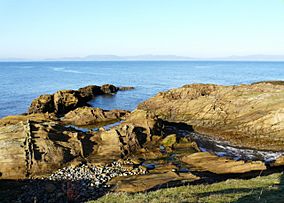Dornoch Firth facts for kids
Quick facts for kids Dornoch Firth National Scenic Area |
|
|---|---|

Shoreline looking across Dornoch Firth
|
|
| Location | Highland, Scotland |
| Area | 40 km2 (15 sq mi) |
| Established | 1981 |
| Governing body | NatureScot |
| Official name: Dornoch Firth and Loch Fleet | |
| Designated: | 24 March 1997 |
| Reference #: | 897 |
The Dornoch Firth (which means "Dornoch Channel" in Scottish Gaelic) is a long, narrow inlet of the sea. You can find it on the east coast of Highland, in northern Scotland. It acts as a natural border between two areas: Ross and Cromarty to the south and Sutherland to the north.
This beautiful area is special because it's one of Scotland's 40 National Scenic Areas. These areas are chosen for their amazing natural beauty. The Dornoch Firth National Scenic Area covers about 15,782 hectares (that's about 39,000 acres). A big part of this, 4,240 hectares, is the water area of the firth itself. Experts from NatureScot (which used to be called Scottish Natural Heritage) looked at these areas in 2010. They noted that the Dornoch Firth is quite narrow and winding. But it has a surprising mix of landscapes. You'll see rounded hills covered in heather and rocky slopes. The lower parts of these hills often have forests, especially oakwoods. There are also other types of trees, both deciduous and conifer.
The Dornoch Firth is also very important for wildlife. Along with Loch Fleet, it's a Special Protection Area (SPA). This means it's a protected place for birds. It's also a Special Area of Conservation (SAC) with Morrich More. This protects different types of natural homes for animals and plants.
Wildlife in the Dornoch Firth
The Dornoch Firth and Loch Fleet SPA is home to many important birds.
- During the breeding season, you might spot:
* Osprey (Pandion haliaetus)
- In winter, many birds come here to stay warm. These include:
* Bar-tailed godwit (Limosa lapponica) * Greylag goose (Anser anser) * Wigeon (Anas penelope) * Curlew (Numenius arquata) * Dunlin (Calidris alpina alpina) * Oystercatcher (Haematopus ostralegus) * Teal (Anas crecca)
The SAC protects important natural habitats. These include salt meadows and coastal sand dunes. These areas are vital for animals like otters (Lutra lutra) and harbour seals (Phoca vitulina).
Crossing the Dornoch Firth
For a long time, people had to travel a longer way around the firth to get from Inverness to Thurso. But in 1991, a new bridge was built across the firth. This Dornoch Firth Bridge made the A9 road much shorter. Before the bridge, traffic had to go through Bonar Bridge, which was further inland.
There were ideas to build the bridge so that the Far North railway line could also use it. This would have saved up to 45 minutes on train journeys. But the government didn't provide money for the railway part of the plan. So, only a road bridge was built.
The firth was also the site of a sad event long ago. On August 16, 1809, a ferryboat called the Meikle Ferry disaster sank. It was carrying too many people, and 99 lives were lost.


